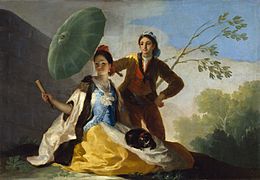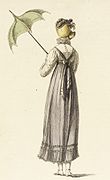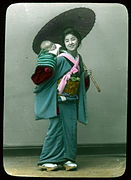parasol

The sunshade (seldom called Parasol in French ) is a commodity that is used to protect against solar radiation . It is a product of the umbrella maker , but nowadays it is mainly manufactured industrially. A general distinction is made between two basic types of parasols:
- Manual parasols: are carried in one hand like an umbrella as mobile sun protection.
- Large umbrellas: are set up using an umbrella stand and are used, for example, as restaurant and beach umbrellas.
Just like an umbrella , a parasol nowadays consists of a covering made of fabric or plastic , which is stretched over spokes and held up by a vertically attached handle . Parasols whose standpipe is not in the center but outside of the parasol surface are called cantilever parasols, cantilever parasols, gallows parasols, pendulum parasols or side-mast parasols. If the canopy of a hand-held parasol is made of material that protects the user from both sunlight and rain, it can also be referred to as an end -to-end or all-weather umbrella .
history

While in Central Europe sunshades are almost exclusively used as large, standing umbrellas (e.g. at seaside resorts, in street cafes and on balconies), until the early 20th century they were mainly carried by hand. These variants differ from umbrellas mainly in that they are not weatherproof: In East Asia (e.g. Japan, Indonesia or Burma), paper was stretched over the spokes as an umbrella material. In other regions people made umbrellas out of straw.
The parasol is much older than the umbrella. The first representations can be found in ancient times in Egypt , Persia and China . They are first mentioned in writing in ancient Greek (e.g. Aristophanes ) and ancient Roman texts (e.g. Martial ). The early forms are usually large canopies held by servants , which, in addition to their function as sun protection, also functioned as status symbols.
In India, too, an ornate parasol (chhatra-ratna, umbrella jewel) was part of the regalia of a king, like the crown and throne. As a king symbol, it is also one of the eight Tibetan lucky symbols. In the same tradition, Buddhist temples in Myanmar and Thailand are crowned with stylized parasols.

In medieval Europe, the portable hand-held parasol seems to be forgotten and is only detectable again in Italy in the 16th century . Such screens were z. B. covered with red velvet and were occasionally worn by pages . Around the 17th century, the portable parasol was introduced to the French court by Maria de Medici . From then on it developed into an important fashion accessory for women, who used it to protect their white, flawless skin from sun damage. The hand-held parasol had a straight horn handle , the struts were made of wood or whalebone . The size and color of the shade, the length of the stem, and the number of spokes changed with fashion.
The parasol was apparently particularly widespread in the 19th century, when it appears on numerous paintings , in fashion journals and later in photographs; on the one hand it was a useful addition to the sun hat , on the other hand it was also an extremely elegant fashion utensil, sometimes delicately small or with lace , frills and fringes . Around 1815, the so-called Knicker appeared in addition to normal umbrellas : a small parasol with a handle that could be bent so that it could also keep out the sun's rays at an angle. There were also sunshades in the so-called “pagoda shape”, where the tip of the umbrella roof is slightly higher than normal. Around 1870, an all-purpose umbrella that could be used both as a sun and an umbrella was called “En tous cas” (French: “for all cases”).
Until the 1920s, the parasol was an essential accessory for women when they were outdoors. Nowadays, smaller parasols are very often attached to strollers to protect sensitive baby skin .
Light skin as an ideal of beauty

The modern trend of suntan only developed relatively recently (around the middle of the 20th century) in the USA and Europe. Previously, for centuries to millennia, a fair complexion was an important feature of attractiveness , especially for women . Above all, he was considered to be typically female, because women in historical and traditional societies spent most of their time in the sun-protected house. Traditionally, only men and women who, from a social point of view, performed “low” jobs (such as farmers or construction workers) worked outdoors. In some cases it was even considered very improper for a woman to leave the house. This view persisted, for example, in the southern European countries of Spain, Italy and Portugal well into the 20th century. Even today one still speaks of a "noble paleness", although the people concerned tend to be accused of condescending arrogance. The harmful effect of the sun's rays on premature skin aging was also known for a long time, so sun protection also served to maintain a youthful appearance for as long as possible. Sun protection creams were not developed until after 1930. This is why the white skin was protected from sun damage by wide hats and parasols well into the 20th century.
In more southern countries like Spain and Portugal , but especially in East Asia (Japan, China and Taiwan ), portable parasols are still used today, still practically exclusively by women . The main reasons for using it are protection against UV radiation , heat, the effects of aging and the preservation of a certain complexion.
- The parasol through the ages
Anthony van Dyck : Marchesa Elena Grimaldi, wife of Marchese Nicola Cattaneo , around 1623.
“Lady walking in the country”. From: Recueil des modes de la cour de France , approx. 1675–1677
Jean-Honoré Fragonard : The Musical Contest , 1754
Francisco de Goya : The Parasol ( El quitasol ), 1777
Edvard Munch , Spring on the Road, 1890
Large umbrellas and their evolution
While the popularity of portable handheld parasols has decreased significantly, large parasols have become more widespread. Especially with the emerging discussion about the harmful effects of UV radiation , the development of sunshades has taken off again since the mid-1980s.
material
Due to the larger dimensions of the umbrellas and the need for protection (against UV radiation), the demands on the material have risen sharply, so that today aluminum is mainly used for the frame and polyester and acrylic fibers are used for the umbrella material .
- The umbrella fabric in particular is susceptible to soiling, mold and fading from sunlight. Since sunshades often serve as advertising space and digital printing is often used as a method, such models are susceptible to fading from solar radiation. However, if a screen printing process is used, sunshades achieve higher lightfastness and thus withstand solar radiation for longer.
- To increase the stability of parasols, glass fiber reinforced plastic is also used in the latest developments . Among other things, this offers the advantage of being able to absorb deformations without damaging the material. State-of-the-art developments, such as B. the Dalia parasol, integrate solar panels into the umbrella fabric so that they can not only be used as a source of shade, but also as an energy producer.
Special constructions
It is the merit of the membrane construction - "Pope" Frei Otto , to have fundamentally transferred the umbrella from the individually available commodity to a developable lightweight architecture. In an umbrella study in the 1960s, Frei Otto laid the foundations for the development of convertible large umbrellas that span space and built the first large convertible umbrellas with a diameter of 19 meters for the Federal Garden Show in Cologne in 1971. The funnel shape of the open umbrella allows rainwater to be drained through the mast pipe and the umbrellas to be set up so that they overlap. Today there are a multitude of variants (from the traditional central mast umbrella to the funnel umbrella - with a cup-shaped membrane - to the triangular umbrella for corner shading) and sizes as standard umbrellas with a diameter of up to 10 m.
Mahmoud Bodo Rasch and his office SL Rasch realized the largest convertible umbrellas to date as shade roofs for the pilgrimage site in Medina , Saudi Arabia (26 m × 26 m) and in front of the Al-Hussein Mosque in Cairo (29 m × 29 m). In summer the umbrellas open depending on the position of the sun and close again in the evening to release the warm air into the night sky. In winter, the umbrellas only open towards sunset and thus keep the warmth of the day in the rooms. Modern convertible funnel umbrellas serve as shade canopies, can protect against rain if they are arranged overlapping, and can also be used to regulate the climate.
Materials such as steel and PTFE are used in the construction of convertible large umbrellas .
Special large umbrellas
- Traffic light umbrellas: These are parasols that have their mast on the side. This has the advantage that the mast does not protrude in the middle of the table, but can be placed to the side of the table. This means that a much larger area can be covered. The disadvantage is that it is a bit more unstable as a result. This means that a heavy stand is required, which makes the umbrella significantly more expensive.
- Funnel umbrellas: This type of parasol has a funnel-like shape that differs significantly from the known variations. The special shape has the advantage over conventional umbrellas that rain can be drawn off via the central mast. This means that there are no waterfalls at the edges that you have to cross when parking. Above all, however, they differ optically from most variants and are therefore also often used by the catering , advertising and event industries to stand out from the competition.
literature
- Ludmila Kybalová, Olga Herbenová, Milena Lamarová: The great image lexicon of fashion - from antiquity to the present. Translated by Joachim Wachtel. Bertelsmann, Gütersloh, 1966, DNB 457330481 .
Web links
- William Sangster: Umbrellas and their History. 1871, archived from the original on June 26, 2009 .
Individual evidence
- ↑ En-tout-Cas - spelling, meaning, definition, origin. In: duden.de. Retrieved July 13, 2018 .
- ^ William Sangster: Umbrellas and their History. 1871, archived from the original on June 26, 2009 ; accessed on August 15, 2020 (English).
- ↑ a b c Ludmila Kybalová, Olga Herbenová, Milena Lamarová: The great image lexicon of fashion - from antiquity to the present. Translated by Joachim Wachtel. Bertelsmann, Gütersloh, 1966, DNB 457330481 , p. 474.
- ↑ a b Ludmila Kybalová, Olga Herbenová, Milena Lamarová: The great image lexicon of fashion - from antiquity to the present. Translated by Joachim Wachtel. Bertelsmann, Gütersloh, 1966, DNB 457330481 , pp. 470, 473, 474, 476 f.
- ↑ a b Alexa Bender: Parasols: dating, buying, restoring. In: marquise.de. Retrieved June 3, 2018 .
- ↑ According to Alexa Bender, Knicker existed “from approx. 1800 to the 1870s”, “whereby around 1840–60 the high time of Knicker”. Alexa Bender: Parasols: date, buy, restore. In: marquise.de. Retrieved June 3, 2018 .
- ↑ Ludmila Kybalová, Olga Herbenová, Milena Lamarová: The great image lexicon of fashion - from antiquity to the present. Translated by Joachim Wachtel. Bertelsmann, Gütersloh, 1966, DNB 457330481 , p. 470.
- ↑ Ludmila Kybalová, Olga Herbenová, Milena Lamarová: The great image lexicon of fashion - from antiquity to the present. Translated by Joachim Wachtel. Bertelsmann, Gütersloh, 1966, DNB 457330481 , pp. 474, 477 (Fig. 785: Various parasols in Vogue from 1928).
- ^ Winfried Nerdinger: Frei Otto. The complete work: light construction, natural design. 2005, ISBN 3-7643-7233-8 .
- ↑ Ralf Hoppe: Islam: Allah's shadow man. In: Der Spiegel , 15/2002. April 8, 2002, pp. 80-84 , accessed August 15, 2020 .
- ↑ Bodo Rasch: Changeable roofs. (pdf; 1 MB) In: Arch + 107. September 29, 2010, pp. 42–44 , accessed on August 15, 2020 .


















